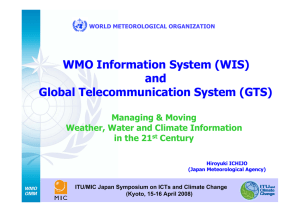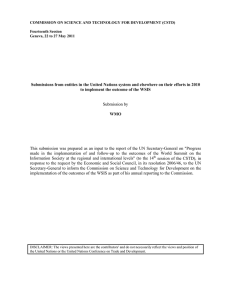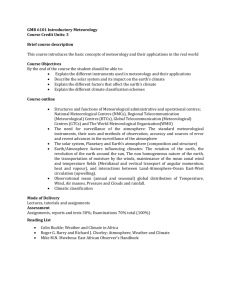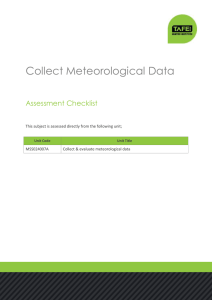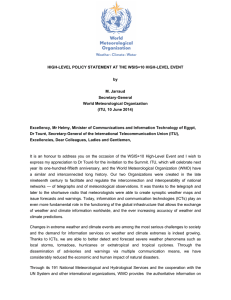WMO Information System (WIS) Managing & Moving Weather, Water and Climate Information
advertisement
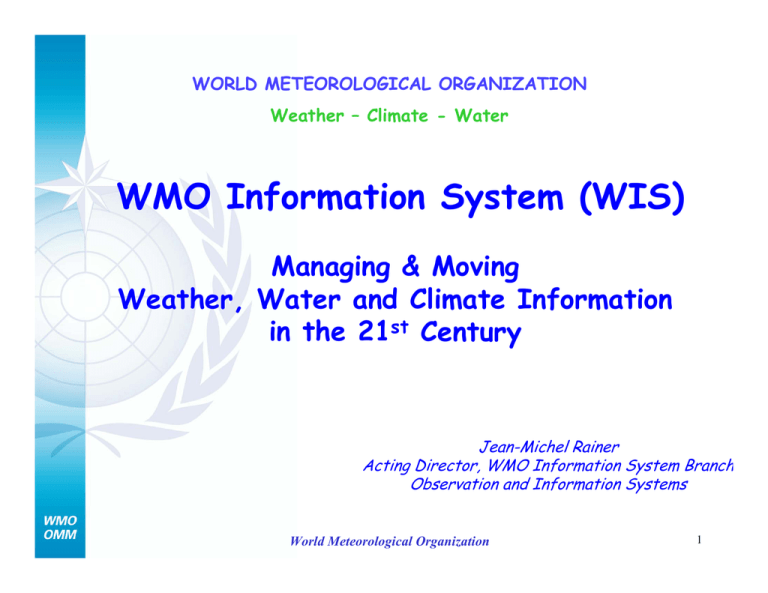
WORLD METEOROLOGICAL ORGANIZATION Weather – Climate - Water WMO Information System (WIS) Managing & Moving Weather, Water and Climate Information in the 21st Century Jean-Michel Rainer Acting Director, WMO Information System Branch Observation and Information Systems World Meteorological Organization 1 How Does the Global Operational Network of WMO Operate? NMHSs of 187 countries contribute to Global Observing System every day Global Telecommunication System- 32 Regional Tele-communication Hubs 3 World Meteorological Centres 40 Regional Specialized Centers NMHSs deliver data and early warning services World Meteorological Organization 2 Current situation: GTS WWW GTS Regional/Specialized Meteorological Centres Meteorological and R&D Satellite Operator Centres interconnects National Meteorological Centres World Meteorological Centres World Meteorological Organization 3 RTH in Region II NMC in Region II 64K Khabarovsk Moscow Centre in other region Washington 64K 64K MTN circuit Regional circuit Interregional circuit Additional circuit NI 24-19.2K (V.34) Toulouse Novosibirsk Almaty 19.2-24K (V.34) No implementation Non-IP link IP link Internet E-mail transmission Internet 9.6-26.4K (V.34) NI Ulaanbaatar 64K CMA PCVSAT EUMETSAT 1M 2.4K 2M 512K NI 64K Kuwait Kabul Karachi Internet 64K 128K Internet 75 2M 1200 Abu-Dhabi NI Internet MPLS Melbourne 64K 64K Internet Kathmandu ISDN 128K 1M Hanoi IMTN MDCN MPLS Moscow Dhaka 128K Internet Cairo 64K Internet F/R CIR <16/16K> 50 200 Yangon 64K F/R CIR <16/16K> 9.6K Vientiane Colombo Sanaa Macao CMA PCVSAT 100 1200 50 64K F/R CIR <16/16K> Hong Kong CMA PCVSAT 50 128K Internet Muscat 64K 64K 75 NI MPLS Internet Internet Seoul Offenbach New Delhi 2M Algiers IMTN MDCN 2M MPLS Male 32K F/R CIR <16/16K> F/R CIR <32/32K> 2M Thimpu 200 64K Washington 100 Doha Beijing IMTN MDCN MPLS NI Bahrain 64K Internet NI IMTN MDCN MPLS 2M 2M MPLS 2M 128K 50 Jeddah 50 Dushanbe Offenbach 64K 512K Tehran Internet IMTN MDCN MPLS Internet 768K Tokyo 14.4K Tashkent NI 14.4-28.8K (V.34) PyongYang via Moscow 9.6-26.4K (V.34) Baghdad NI via Moscow 2M 28.8-9.6K (V.34) Bishkek Ashgabad IMTN-MDCN CIR<32/768K> 14.4-28.8K (V.34) MPLS 9.6-26.4K (V.34) NI 512K IMTN-MDCN CIR<16/32K> Manila Bangkok Internet 75 Phnom Penh Singapore F/R CIR <16/16K> Regional Meteorological Telecommunication Network for Region II (Asia) World Current status as of 15 December 2007 Meteorological Organization F/R CIR <16/16K> Melbourne Kuala Lumpur 4 Satellite-based data-distribution systems: e.g. coverage of RETIM-Africa, EUMETCast 38 RETIM receiving stations in 18 RA I Countries All RA I Countries equipped with EUMETCast receiving stations World Meteorological Organization 5 Use of GTS for dissemination of Interim Tsunami Watch Information (TWI) for the Indian Ocean issued by Honolulu (PTWC) and Tokyo (JMA) Washington Exeter Toulouse Algiers Dakar Brasilia Offenbach Prague Sofia Cairo Honolulu (PTWC) Moscow Beijing Tehran Tokyo (JMA) New Delhi Karachi Dhaka Abu-Dhabi Yangon Jeddah Muscat Bangkok Sanaa Djibouti Kuala Lumpur Male Singapore Colombo Mogadiscio Nairobi Seychelles Jakarta Moroni Dar Es Salaam Mauritius Antananarivo St Denis Pretoria Maputo New Amsterdam Melbourne Buenos Aires Kerguelen Tsunami Watch Information center World Meteorological Organization National Meteorological Center in the Indian Ocean Rim 6 WMO's Action Plan for a Fully Operational GTS for the IOTWS Step 1 - Multidisciplinary workshop (Jakarta, March 2005) – Completed Step 2 - GTS operational arrangements & tests for interim TWS – Completed Step 3 - WMO Expert missions to NMHSs – Completed Step 4 - Implementation of upgrade to NMHSs' GTS capabilities - Completed Step 5 - WMO Training on GTS operations - Completed Step 6 – Regional operational tests – Current quarterly tests of tsunami advisories distribution by JMA Tokyo World Meteorological Organization 7 WMO Information System (WIS) WMO Congress decided: – – An over-arching approach for solving data management problems for all WMO and related international programmes A single, coordinated global infrastructure, the WMO Information System (WIS) for the collection and sharing of information World Meteorological Organization 8 WIS Vision Integrated approach for all WMO Programmes • Routine collection and dissemination of time-critical and operation-critical data and products: o Real-time “push” through dedicated telecommunication • Data Discovery, Access and Retrieval service: o “Pull” through the Internet (HTTP, FTP,…) • Timely delivery of data and products: o Delayed mode “push” through dedicated telecommunication means and public data networks, especially the Internet • Unified procedures o More efficient data exchange • Coordinated and standardized metadata o Interoperability between programmes o Improved data management o ISO 191xxx series for geographic information World Meteorological Organization 9 WIS World Radiation Centre International Organizations (IAEA, CTBTO, UNEP, FAO.. ) Regional Instrument Centres IRI, Hadley Centre, and other climate research centres; Universities; Regional Climate Centres (CIIFEN, etc.) GAW World Data Centres GCOS Data Centres Global Run-off Data Centre DCPC NC Global Precip. Climatology Centre NC NC/ DCPC NC/ DCPC Commercial Service Providers NC NC GISC NC GISC GISC International Projects (e.g. GMES HALO) NC DCPC internet NC DCPC GISC GISC Satellite Two-Way Systems Satellite Dissemination (IGDDS, RETIM, etc) NC World Meteorological Organization WMO World Data Centres NC NC Real-time “push” On-demand “pull” 10 WIS brings new features and opportunities • Common information exchange standards, functions and services for all WMO programmes • Inter-disciplinary discovery, retrieval and exchange of information in real-time and non-real time • Inter-operability through on-line catalogues using metadata based on ISO 19100 (geographic information standard) • Industry standards and off-the-shelf hardware and software systems to ensure cost-effectiveness and compatibility World Meteorological Organization 11 What will a NMHS gain from the WIS? 1. Improved forecasting/warning services • 2. Faster and more cost-effective exchange of operationcritical information; Improved and expanded range of services • Discovery and access to new data and products: o 3. Satellite data and products, ensemble prediction products, climate predictions, oceanographic data and products, operational, and research data and products, reports, publications Strengthened role as national service provider • Ability to “push” to national users critical information: o 4. Warnings, advisories, selected measurements, etc.; (eg: national agencies dealing in disaster mitigation, agriculture, energy and water management,) Better appreciation by partner agencies • Supports their “pulling” relevant information from WMO World Meteorological Organization 12 Structure of WIS Functional centres: • National Centres (NC) • Global Information System Centres (GISC) • Data Collection or Production Centres (DCPC) and • Data communication networks WIS concerns only information exchange and data management functions World Meteorological Organization 13 Structure of WIS Functional centres interconnected by data communication networks: • National Centres (NC) – Links national data providers and users to regional and global data exchange nodes, and administrates access to WIS • Data Collection and Production Centres (DCPC) – Provides for regional and international exchange of WMO programmes’ data and products – Supports data and information push and pull • Global Information System Centres (GISC) – Provides for global exchange of data and products – Collects and provides metadata for all data and products – Supports data and information discovery and pull World Meteorological Organization 14 WIS, a key issue: interoperability Interoperability enables the discovery, the retrieval and the usage of the data 9It needs the development and the implementation of relevant Metadata standards 9Development of a WMO Metadata Profile of the ISO 191xx series for geographic information World Meteorological Organization 15 WIS SERVICES WIS provide three types of services to meet the different requirements: (1) Routine collection and dissemination service for time-critical and operation-critical data and products: Based on real-time “push” mechanism (incl. Multicast); implemented essentially through dedicated telecommunication means with guaranteed quality of service, e.g. leased circuits, dedicated data communication network services and satellite-based datadistribution systems; (2) Data Discovery, Access and Retrieval service: Based on request/reply “pull” mechanism with relevant data management functions; implemented essentially through the Internet (HTTP, FTP,…); (3) Timely delivery service for data and products: Based on delayed mode “push” mechanism; implemented through a combination of dedicated telecommunication means and of public data networks, especially the Internet. World Meteorological Organization 16 WIS DATA-COMMUNICATIONS IMPLEMENTATION (for weather, water, climate and related data and products) DAR Essentially through the Internet (HTTP, FTP, VPN…) WIS Essentially through telecom. with guaranteed quality of GTS service, e.g. leased circuits, dedicated data com network services, sat.-based systems, .. Data pull Essentially through satellite based data IGDDS distribution systems, e.g. DVB-S WIS/GTS: for time and operation-critical data & products WIS/IGDDS: for space-based data & products WIS/DAR: data discovery, access and retrieval Data push: routine distribution of data & products Data pull: access to and retrieval of data &World products Meteorological Organization Data push 17 IGDDS within the WIS LEO satellites GEO satellites Global data (recorded/dumped) in the region R&D Polar orbiting satellites Network of HRPT stations satellites RARS Satellite products Local processing Central processing Data exchange with other DCPCs Central processing Local processing Local processing Regional processing DCPC Data, metadata & user management GISC Interoperability (Data, metadata and user management) Routine Dissemination Request/ Request/reply reply (Internet) (Internet) ADM ADM Other Other media media Request/ Request/reply reply (Internet) (Internet) National centres and other users World Meteorological Organization 18 WIS implementation • Part A: GTS Evolution into WIS – Provides consolidation/improvement for timecritical and operation-critical data – Includes extension to meet operational requirements of all WMO programmes in addition to World Weather Watch • Part B: Extension to WIS – Provides for an extension of the information services through flexible data discovery, access and retrieval services to all users, as well as flexible timely delivery services World Meteorological Organization 19 Jan-03 Feb-03 Mar-03 Apr-03 May-03 Jun-03 Jul-03 Aug-03 Sep-03 Oct-03 Nov-03 Dec-03 Jan-04 Feb-04 Mar-04 Apr-04 May-04 Jun-04 Jul-04 Aug-04 Sep-04 Oct-04 Nov-04 Dec-04 Jan-05 Feb-05 Mar-05 Apr-05 May-05 Jun-05 Jul-05 Aug-05 Sep-05 Oct-05 Nov-05 Dec-05 Jan-06 Feb-06 Mar-06 Apr-06 Megabytes Jan-03 Data input Nov-04 Apr-06 Mar-06 Feb-06 Jan-06 Dec-05 Nov-05 Oct-05 Sep-05 Aug-05 Jul-05 Jun-05 May-05 Apr-05 Mar-05 Feb-05 Jan-05 Dec-04 Messages input Oct-04 Sep-04 Aug-04 Jul-04 Jun-04 May-04 Apr-04 Mar-04 Feb-04 Jan-04 Dec-03 Nov-03 Oct-03 Sep-03 Aug-03 Jul-03 Jun-03 May-03 Apr-03 Mar-03 Feb-03 Thousands The GTS: continued improvements Frost 24 hour message volumes input & output 6000.0 Messages output 5000.0 4000.0 3000.0 2000.0 1000.0 0.0 Frost 24 hour data volumes input and output 14000.0 Data output 12000.0 10000.0 8000.0 6000.0 4000.0 2000.0 0.0 World Meteorological Organization 20 WIS Implementation – accomplishments 9 Continued GTS upgrades (IMTN, satellite-based datacast,..) 9 WMO Core metadata 9 Internet portal 9 Basic data acquisition, discovery and push-pull services 9 GISC prototype: RA VI VGISC project 9 DCPCs prototypes: 9 ECMWF & EUMETSAT associated with VGISC project 9 NCAR (Boulder) 9 NODC (Obninsk) for JCOMM related data 9 IGDDS (Space-based data) 9Asia-Pacific VPN pilot project 9Technical Conference on WIS (Korea, 6-8 November 2006); VGISC & DCPC prototype demo World Meteorological Organization 21 European Virtual GISC Project Operational early 2009 World Meteorological Organization 22 Key Future Milestones • Consolidate plans on development, governance and implementation of WIS: 2008-2009 • Develop WIS regulatory documentation and guidance for implementation (GISC & DCPCs interfaces,user interface): 2008 • Develop scheme and practices for security, authentication and authorization procedures for WIS services : 2008-2009 • Implementation of first operational GISC: 1Q 2009 • Implementation of other operational GISCs: 2009 - 2011 • Implementation of DCPCs: 2008-2011 • Outreach & Capacity building: 2008-2011 World Meteorological Organization 23 WIS contribution to GEO W WM MO O Weather Weather Domain Domain Climate Climate Domain Domain Water Water Domain Domain W W II SS Internet Internet GEOGEONetCast NetCast GTS GTS IGDDS IGDDS G GEEO O Health Health Energy Energy Disasters Disasters Weather Weather Climate Climate Ecosystems Ecosystems Water Water Agriculture Agriculture Biodiversity Biodiversity World Meteorological Organization 24 Radio Frequency spectrum for Weather, Water and Climate monitoring Prime importance of specific radiocommunication services for meteorological and related environmental activities for: ¾ prevention, detection, early warning and mitigation of natural and technological (manmade) disasters ¾ safety of life and property ¾ protection of the environment ¾ climate change studies and scientific research, World Meteorological Organization 25 Importance of radiocommunications for weather, water and climate operation and research World Meteorological Organization 26 Radiocommunication Services used for weather, water and climate sciences and operations • Specific radiocommunication services: – – – – Meteorological Aids Service Meteorological-Satellite Service Earth Exploration-Satellite Service (passive) Earth Exploration-Satellite Service (active) • As special systems of generic radiocommunication services: – Meteorological weather radars and Wind-profiler radars of the Radiolocation Service • As users of Radiocommunication Services: – Fixed Service, Mobile Service, etc. World Meteorological Organization 27 Radio Frequency spectrum for Weather, Water and Climate monitoring WMO and its 187 Members (National Meteorological and Hydrological Services and related entities) do their utmost at national, regional and international levels to ensure the availability and protection of suitable RF bands for weather, water and climate monitoring, with particular attention to bands that are a unique natural resource for passive sensing World Meteorological Organization 28 Thank you more information at: http://www.wmo.int/pages/index_en.html http://www.wmo.int/pages/prog/www/index_en.html World Meteorological Organization 29
